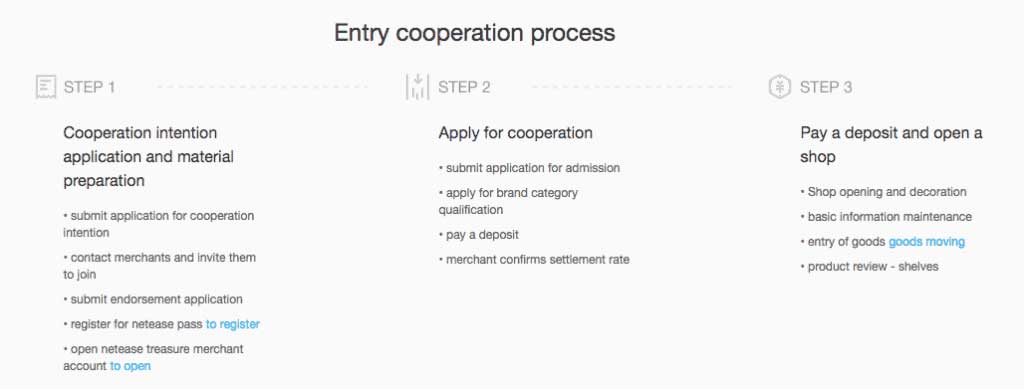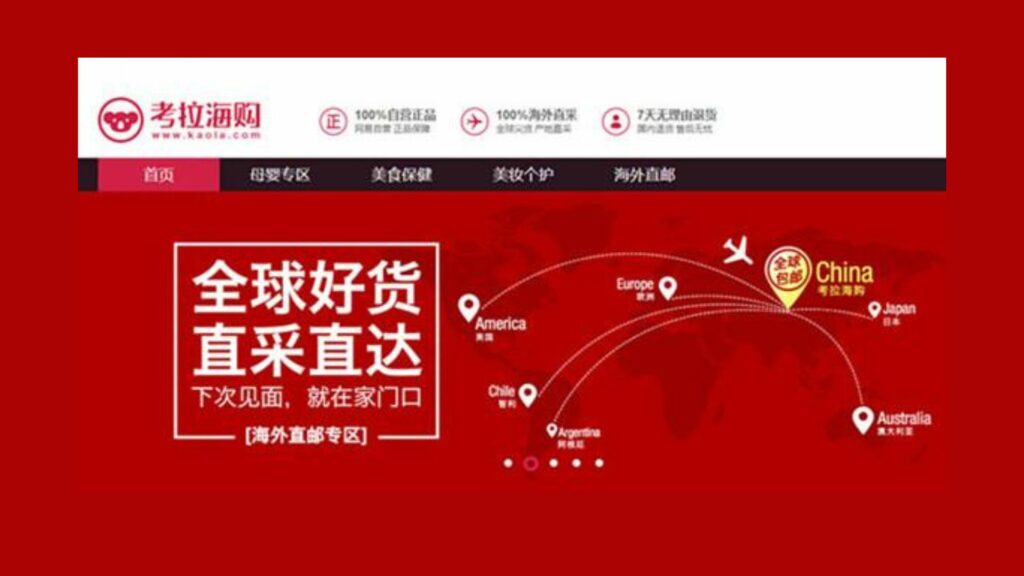The Chinese market has become increasingly important for international businesses seeking growth and expansion. However, entering this market can be daunting with its regulations and unique challenges: understanding the Chinese consumers, cultural differences, rapidly changing trends, and local players.
This is where cross-border e-commerce platforms such as Kaola come to play. It provides a safe and affordable marketplace for international brands to sell their products securely to middle-class Chinese consumers.
We’ll explore what sets Kaola apart from other platforms in China, and how to sell on it effectively. Also, we’ll talk about why it’s an essential part of any comprehensive China market entry strategy.
Kaola The Cross-border Marketplace In China
Kaola is important in China because it provides access to foreign products, helps foreign businesses expand in China, and promotes international cooperation.
China, with over 1.4 billion people, presents immense opportunities for international brands looking to expand their reach and boost revenues.
Chinese consumers are tech-savvy and heavily reliant on e-commerce platforms to make purchases. This has made it easier for international businesses to tap into this without establishing a physical presence in China.
About Kaola – Company and Overview
Kaola launched in 2015, part of Alibaba Group’s global retail division since its acquisition from NetEase in September 2019.
Being owned by industry behemoth Alibaba brings with it several advantages:
- access to immense resources,
- expertise in marketing strategies tailored specifically for Chinese consumers
- streamlined logistics between different divisions within Alibaba’s umbrella
- this ultimately results in improving the overall user experience on the platform.

The Unique Features And Benefits Of Kaola
Kaola offers unique features and benefits that make it an attractive option for international businesses looking to sell their products to Chinese consumers.
Kaola is a strong focus on authenticity and quality control. It has a user-friendly interface and personalized shopping experience. The platform uses sophisticated algorithms to recommend relevant products based on a customer’s browsing history and purchasing behavior.
Kaola also provides support services such as warehousing, logistics, and marketing tools among others that help sellers navigate regulatory requirements in China. Meanwhile, it is providing ongoing assistance throughout its entire business journey.
Target Audience And Popular Product Categories On Kaola
With over 30 million active users, Kaola caters to a growing demographic of professional and affluent Chinese consumers who are looking for high-quality imported products.
Popular Product Categories are:
- Cosmetics (especially skincare and makeup)
- Baby and maternity products
- Health supplements
- Luxury goods (such as designer handbags, watches, and jewelry).
How To Sell On Kaola: A Comprehensive Guide
Setting Up A Kaola Seller Account
As a foreign brand looking to sell on Kaola, the first step is to set up a seller account. Here’s how to get started:
1. Visit the Kaola website and click on “Seller Center” at the top of the page.
2. Fill out the registration form with your company information, including your business license and tax ID.
3. Submit your application for approval, which can take up to 10 working days.
4. Once approved, log in to your Kaola seller account and complete your profile information.
5. Upload your product listings onto the platform, making sure they meet Kaola’s requirements and regulations.
6. Set up payment and delivery options for your customers.
7. Start promoting your store through marketing campaigns and promotions on the platform.

It’s important to note that there are costs associated with selling on Kaola, such as transaction fees and shipping costs. Additionally, sellers must comply with Chinese regulations regarding the importation of goods and taxes.
Regulations And Requirements For Selling On Kaola
Selling on Kaola, the cross-border e-commerce platform in China requires international brands to comply with several regulations and requirements set by the Chinese government.
To start selling on Kaola, foreign companies need to register first as legal entities in China and obtain the necessary licenses for cross-border trading.
Sellers must use a licensed Chinese payment provider that is integrated with Kaola’s system. Shipping is also an essential aspect of selling on Kaola, as fast and reliable delivery is crucial to satisfying customers’ needs.
All these things might sound daunting, but our agency has more than 20 years of experience. We can help you get these things done smoothly, just contact us!
Fulfillment And Logistics: Options And Recommendations
Kaola provides sellers with a warehousing and fulfillment service that allows them to store their products in China. They also offer direct delivery to the customer upon purchase. This is a convenient option for sellers who want to avoid navigating Chinese fulfillment and logistics themselves.
Third-party logistics providers can help sellers manage their inventory and shipping needs in China while providing access to additional services such as customs clearance and return management. Partnering with local shipping providers can help ensure fast and reliable delivery within China.
Ensuring your packaging meets Chinese standards (such as labeling requirements) can help prevent delays or rejection at customs. Minimizing the size of packages can reduce shipping costs.
Regularly tracking shipping times, delivery rates, and other logistics metrics can help identify areas for improvement in the fulfillment process.

Best Practices For Marketing Strategies and Optimizing Sales On The Platform
If you want to effectively optimize your sales strategy on Kaola while improving your brand awareness among Chinese consumers, follow these practices:
- Use Kaola’s analytics tools to track sales data, measure performance metrics, and identify opportunities for improvement.
- Ensure your product titles, descriptions, images, and pricing are all optimized for the Chinese market.
- Your product images are high-quality and showcase the features of the product clearly.
- Set competitive prices that align with consumer expectations and competitors’ offerings.
- Provide discounts and coupons for first-time buyers or loyal customers to encourage repeat purchases.
- Use targeted marketing campaigns to reach specific customer segments and promote products based on interest or preference.
- Partner with popular Chinese influencers or KOLs (Key Opinion Leaders) to promote your products on their social media channels.
- Take advantage of Kaola’s built-in promotional tools. Flash sales or group-buy campaigns can drive traffic and increase visibility.
- Use pay-per-click advertising on Kaola’s platform to increase the visibility of your products.
- Consider offering bundled packages or promoting complementary products to increase order value and revenue.
- Encourage customers to leave reviews and ratings. These can increase trust and interest in your products.
Kaola Compared To Other Cross-border E-commerce Platforms
If you’re considering selling in China’s booming cross-border e-commerce market, it’s critical to understand the differences between the platforms before making your decision.
A Comparative Analysis Of Tmall Global, JD Worldwide, And Kaola
| Platform | Ownership | Market Share | Main Features | Target Audience | Popular Product Categories |
|---|---|---|---|---|---|
| Tmall Global | Alibaba Group | Second largest in China’s cross-border import retail e-commerce market | – Flagship Store model – Supports multiple languages – Wide range of product categories | Global Brands targeting Chinese consumers | Apparel, Cosmetics, Home Appliances, Baby Products |
| JD Worldwide | JD.com | Third largest in China’s cross-border import retail e-commerce market | – Direct sales and marketplace models – Focus on product authenticity – Extensive logistics network | Global Brands targeting Chinese consumers | Electronics, Home Appliances, Baby Products, Cosmetics |
| Kaola | NetEase | Largest in China’s cross-border import retail e-commerce market | – Curated selection of products – Focus on quality assurance – Exclusive products and discounts | Global Brands targeting Chinese consumers | Cosmetics, Baby Products, Health Products, Food & Beverages |
This comparative analysis highlights the unique features, target audience, and popular product categories of each platform. This is helping prospective sellers to choose the best platform for their brand’s needs. To succeed in the Chinese cross-border e-commerce market, it’s essential to understand each platform’s landscape. You need to develop a strategy that capitalizes on their unique benefits.
The Advantages And Disadvantages Of Using Kaola
As with any e-commerce platform, there are both advantages and disadvantages to using Kaola for cross-border sales in China. Kaola has a strong focus on quality control and authenticity. This can help build trust with Chinese consumers who are often wary of counterfeit products.
Kaola may have lower traffic compared to other cross-border e-commerce platforms in China like Tmall Global or JD Worldwide.
Another disadvantage may be the setting up. A seller account on the platform is relatively straightforward, the application process can take some time due to verification requirements.
Case Studies: Success Stories Of Brands On Kaola And Other Platforms
Kaola has been instrumental in helping global brands reach China’s growing middle market.
Vitabiotics, a UK-based vitamin company expanded its business to China through Kaola. Since joining the platform, Vitabiotics has experienced exponential growth in sales with revenue doubling year-on-year.
California Baby is a natural skincare brand that also entered the Chinese market through Kaola.

Navigating The Chinese E-commerce Landscape
Understanding Chinese Consumers
China has unique shopping habits shaped by cultural, economic, and social factors. Moreover, mobile devices have transformed how Chinese consumers shop; they are more likely to use their smartphones for researching products and making purchases than their desktops.
Another key factor is being aware of local holidays’ significance throughout the year. For instance, Singles Day (November 11th) generates massive revenue as many shoppers take advantage of discounts during this highly celebrated holiday.
Adapting Your Brand And Products For The Chinese Market
Adapting your brand and products for the Chinese market is essential to successfully selling on Kaola. A well-thought-out localization strategy is crucial considering language, culture, preferences, and regulations
The packaging of products should also be tailored to Chinese consumers’ tastes as a cultural show of respect.
It’s important to consider payment options that are popular with Chinese consumers such as Alipay or WeChat Pay for seamless transactions. Brands should also make use of social media platforms like WeChat and Sina Weibo which are widely used by consumers for product research before making purchases.
The Future Of Kaola
With its unique features and benefits, coupled with the growing demand for cross-border e-commerce in China, we can expect Kaola to continue expanding over the next few years.
Alibaba’s recent acquisition of Kaola has provided it with access to a larger customer base and resources needed for expansion. The company plans on investing heavily in technology and logistics infrastructure. And they also want to expand into new markets both domestically and internationally.
According to research firm eMarketer, China’s cross-border e-commerce market reached $215 billion in 2022, up from $128.1 billion in 2017.
Companies must adapt their strategies to stand out among competitors. The growth of social commerce and livestreaming shopping is also contributing to the transformation of the Chinese e-commerce market.

Building A Comprehensive China Market Entry Strategy
To ensure success on Kaola and in the Chinese market, it’s essential to have a well-rounded strategy.
Integrating Kaola Into Your Overall China Market Entry Plan
Conduct thorough research on the Chinese market and target audience. Include regional differences, consumer behavior, and purchasing habits.
Adapt your brand and products to appeal to Chinese consumers by considering cultural nuances and preferences.
Ensure compliance with Chinese regulations and requirements for cross-border e-commerce platforms such as Kaola.
Determine the best fulfillment and logistics options that align with Kaola’s requirements and recommendations, including warehousing, shipping, payments, and returns.
Develop selling strategies specific to Kaola’s platform, including pricing competitiveness, marketing tactics, customer service plans, and product selection optimization, amongst others.
Consider offline retail store partnerships or other online-to-offline channels to reach a broader audience beyond Kaola’s platform.
The Role Of Offline Retail And O2O (Online-to-Offline) Channels
In recent years, companies like Alibaba have invested heavily in creating an O2O ecosystem that connects online and offline shopping experiences seamlessly.
For example, consumers can order products online and pick them up at a physical store or use mobile devices to access coupons while shopping in-store.
Understanding O2O is crucial for selling on Kaola or other cross-border marketplaces in China. Kaola has a vast network of physical stores. Sellers can boost brand recognition with creative marketing campaigns spanning both digital and traditional channels.
Partnerships And Collaborations With Local Companies
To effectively meet Chinese consumers’ needs, collaborate with experienced local partners. Gain valuable insights into their behavior and preferences.
Collaborations can also establish trust and build a loyal customer base. Working with popular influencers or well-known brands can greatly improve reputation among potential customers.

Key Takeaways on Kaola Crossborder E-commerce Platform
If you’re an international brand looking to expand into the Chinese market, Kaola is definitely a platform worth considering. It has affordable pricing and unique features such as self-pricing and customized marketing strategies.
It is essential to understand Kaola’s unique features and target audience. The top-selling product categories on the platform include beauty products, baby products, and health supplements.
Kaola is optimizing your logistics and fulfillment channels. The platform offers various shipping methods that cater to the different preferences and budgets of both sellers and buyers.
If you need professional help, don’t hesitate to send us a message. We’re always available to assist you.

